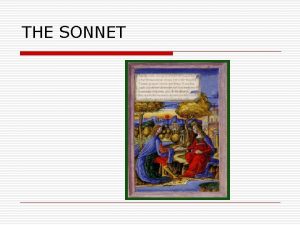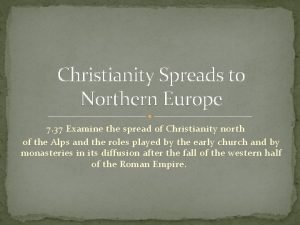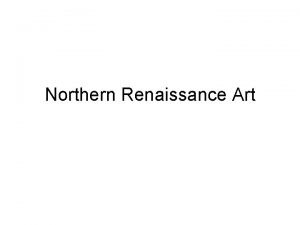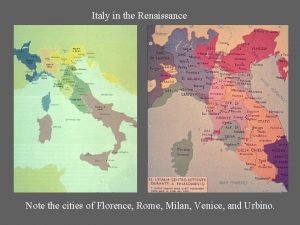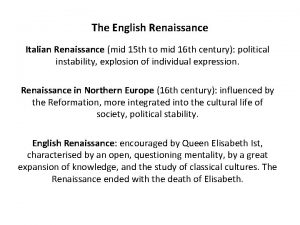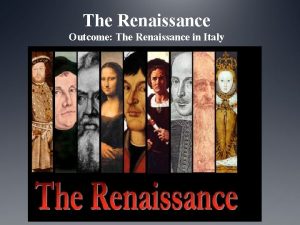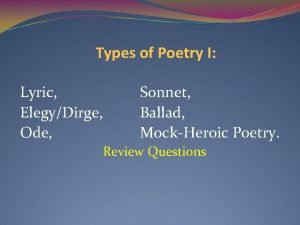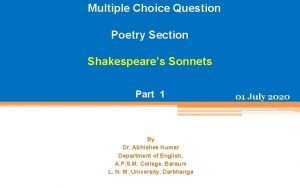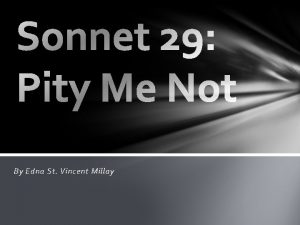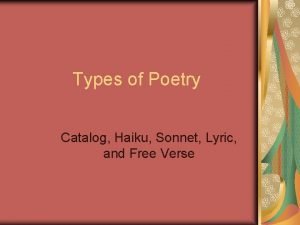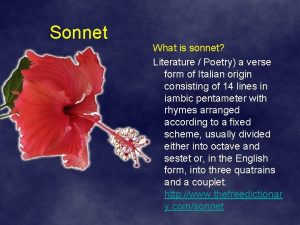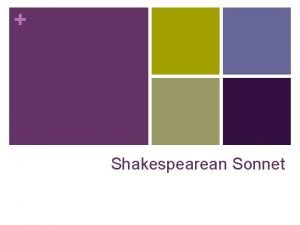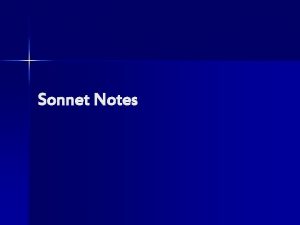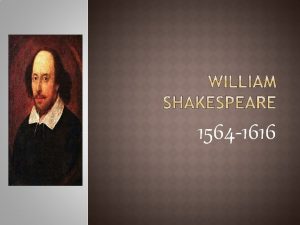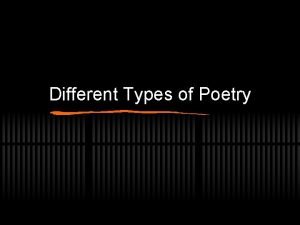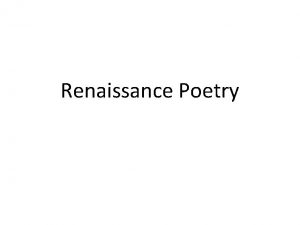Lecture 5 Poetry The Sonnet Renaissance Literature Deanship

















- Slides: 17


Lecture 5 Poetry: The Sonnet Renaissance Literature ﻋﻤﺎﺩﺓ ﺍﻟﺘﻌﻠﻢ ﺍﻹﻟﻜﺘﺮﻭﻧﻲ ﻭﺍﻟﺘﻌﻠﻴﻢ ﻋﻦ ﺑﻌﺪ Deanship of E-Learning and Distance Education [ ] ﺟﺎﻣﻌﺔ ﺍﻟﻤﻠﻚ ﻓﻴﺼﻞ King Faisal University

Classical Influence on Renaissance Poetry v. The growth of poetry in Renaissance England was profoundly influenced by renewed interest in classical poetry. v. Classical poetry encouraged granting the poet a higher social status and provided a rich storehouse of poetic styles and genres. v. Classical poetry also provided a system of classification: ü the Pastoral was seen as the humblest ü the Epic as the most prestigious. v. The most ambitious Renaissance poets imitated the poetic career of Virgil: they began as authors of pastoral poetry and gradually worked their way up to the epic (a pathway called the “Virgilian wheel”). ﻋﻤﺎﺩﺓ ﺍﻟﺘﻌﻠﻢ ﺍﻹﻟﻜﺘﺮﻭﻧﻲ ﻭﺍﻟﺘﻌﻠﻴﻢ ﻋﻦ ﺑﻌﺪ Deanship of E-Learning and Distance Education [ 3 ] ﺟﺎﻣﻌﺔ ﺍﻟﻤﻠﻚ ﻓﻴﺼﻞ King Faisal University

Classical Influence (cont) v. The Pastoral: Theocritus’ Idylls (3 rd century BC); Virgil’s Eclogues (37 BC); Georgics (29 BC). v. The Epic: Homer’s The Iliad and The Odyssey (600 BC); Virgil’s The Aeneid (29 -19 BC). v. Love Poetry: Ovid’s Metamorphoses (43 BC, translated in 1565) was especially influential. Its mythological tales were a rich resource on love and desire, and its stylistic elegance offered a model to emulate. v. Ovid was controversial as an ethical model. Some critics hailed him as a teacher of great wisdom and learning and others condemned him as a corrupter of youth. v. Satiric Poetry: Horace and Juvenal offered contrasting models. ﻋﻤﺎﺩﺓ ﺍﻟﺘﻌﻠﻢ ﺍﻹﻟﻜﺘﺮﻭﻧﻲ ﻭﺍﻟﺘﻌﻠﻴﻢ ﻋﻦ ﺑﻌﺪ Deanship of E-Learning and Distance Education [ 4 ] ﺟﺎﻣﻌﺔ ﺍﻟﻤﻠﻚ ﻓﻴﺼﻞ King Faisal University

Native and Contemporary Influence v. The Pastoral: influenced by Medieval English authors like William Langland contemporary continental pastoralists like Jacopo Sannazaro v. The Epic: Influenced also by Medieval English romance like Sir Gawain and the Green Knight, written 1375 -1400), Italian poems like Dante’s The Divine Comedy (written 1308 -21), Ariosto’s Orlando Furioso (1516, 1532), and Tasso’s Gerusalemme Liberata (1581) v. The Sonnet/Petrarchism: Takes its name from Italian poet Francesco Petrarch (1304 -74), most famous for his Canzoniere (written 1327 -68), a sequence of 366 lyric poem, about the poet’s unfulfilled love for a beautiful woman called Laura. Most of the poems are sonnets, a new type of poem whose invention is attributed to Giacomo da Lentino in the 13 th century and popularized across Europe by Petrarch’s poems have many recurrent features that quickly became conventional topoi or motifs in European love poetry, now simply called The Petrarchan Mode. ” ﻋﻤﺎﺩﺓ ﺍﻟﺘﻌﻠﻢ ﺍﻹﻟﻜﺘﺮﻭﻧﻲ ﻭﺍﻟﺘﻌﻠﻴﻢ ﻋﻦ ﺑﻌﺪ Deanship of E-Learning and Distance Education [ 5 ] ﺟﺎﻣﻌﺔ ﺍﻟﻤﻠﻚ ﻓﻴﺼﻞ King Faisal University

Royal Courts and Patronage v. In the 16 th century, poetry was a genre closely identified with the royal court. Those who wrote poetry were mostly either courtiers or educated, aspiring men (and occasionally women) in search of royal support. v. For Elizabethan courtiers the ability to write artful poetry was part of being an accomplished gentleman (woman). v. It was also a way of cultivating rhetorical and persuasive skills necessary in Renaissance politics and diplomacy. Poetry was a very good skill to have for people with political ambitions. v. For those outside the court, Poetry was also a way of winning favors or patronage from the monarch, especially for those who now seek to make a living as professional poets. Patronage provided status and income. v. It is for this reason that many of the poets of the Renaissance write about and for the court v. This situation changes in the 17 th century when the rise of the merchant class offered alternative venue for poetry and aspirant poets. ﻋﻤﺎﺩﺓ ﺍﻟﺘﻌﻠﻢ ﺍﻹﻟﻜﺘﺮﻭﻧﻲ ﻭﺍﻟﺘﻌﻠﻴﻢ ﻋﻦ ﺑﻌﺪ Deanship of E-Learning and Distance Education [ 6 ] ﺟﺎﻣﻌﺔ ﺍﻟﻤﻠﻚ ﻓﻴﺼﻞ King Faisal University

From Manuscript to Print v. Most Renaissance poetry circulated in manuscript form, but a series of landmark publications in the late 16 th and early 17 th centuries set a precedent for printing collections of poetry and helped make print the more common form of distribution. v. One of the earliest collections to be published was the Songs and Sonnets that was published by Richard Tottel in 1557, better known as Tottel’s Miscellany. It consisted of previously unpublished lyrics by Henry Howard, Earl of Surrey, Sir Thomas Wyatt and others. v. The movement from manuscript to print took the poems from their original intimate context into the wider public. This obliged publishers to add titles or explanatory prefaces, often explaining how such private poems could be presented to a wider public. v. The success of Tottel’s Miscellany showed that there was a market for printed poetry ﻋﻤﺎﺩﺓ ﺍﻟﺘﻌﻠﻢ ﺍﻹﻟﻜﺘﺮﻭﻧﻲ ﻭﺍﻟﺘﻌﻠﻴﻢ ﻋﻦ ﺑﻌﺪ Deanship of E-Learning and Distance Education [ 7 ] ﺟﺎﻣﻌﺔ ﺍﻟﻤﻠﻚ ﻓﻴﺼﻞ King Faisal University

From Manuscript to Print (cont) v. The posthumous publication of Sir Philip Sidney’s sonnet sequence Astrophil and Stella (1591) and his collected works (1598) also had a significant impact on the history of printed poetry and make it more acceptable, especially among elite poets. v. The Sidney volume set a precedent for the publishing of single author collections, which became very popular and profitable in the early 17 th century. v. In 1616, Ben Johnson went even further and oversaw the publication of his own poetic and dramatic Works in a very attractive Folio edition, a format generally reserved for learned publications. v. This was followed by the similar publication of the First Folio of Shakespeare’s play (1623), and editions of the poems of John Donne and George Herbert in 1633. ﻋﻤﺎﺩﺓ ﺍﻟﺘﻌﻠﻢ ﺍﻹﻟﻜﺘﺮﻭﻧﻲ ﻭﺍﻟﺘﻌﻠﻴﻢ ﻋﻦ ﺑﻌﺪ Deanship of E-Learning and Distance Education [ 8 ] ﺟﺎﻣﻌﺔ ﺍﻟﻤﻠﻚ ﻓﻴﺼﻞ King Faisal University

To Teach and Please v. Early Elizabethan poetry was designed to teach its readers religious, ethical or civic lessons. v. Later Elizabethan poets continued to be concerned with instruction but believed that poetry was more likely to teach its readers if it amused and entertained them. v. Poets still could not say directly what they wanted. The popularity in late Elizabethan period of the pastoral and the sonnet was primarily due to the fact that these two genres allowed poets to say what they wanted indirectly. ﻋﻤﺎﺩﺓ ﺍﻟﺘﻌﻠﻢ ﺍﻹﻟﻜﺘﺮﻭﻧﻲ ﻭﺍﻟﺘﻌﻠﻴﻢ ﻋﻦ ﺑﻌﺪ Deanship of E-Learning and Distance Education [ 9 ] ﺟﺎﻣﻌﺔ ﺍﻟﻤﻠﻚ ﻓﻴﺼﻞ King Faisal University

The Sonnet v. To speak of English Renaissance poetry, one has to start with the Sonnet. This is the literary form that emerged from Italy first and spread across Europe like wildfire. v. In the last decade of the sixteenth century, no other lyric form compared in popularity with the sonnet. v. The sonnet is a short poem usually emotional in content. The form was first developed in Italy during the High Middle Ages by well-known figures like Dante Alighieri putting it to use. But the most famous sonneteer of that time was Francesco Petrarca (1304 -1374), and it is after him that the Italian sonnet got its name. ﻋﻤﺎﺩﺓ ﺍﻟﺘﻌﻠﻢ ﺍﻹﻟﻜﺘﺮﻭﻧﻲ ﻭﺍﻟﺘﻌﻠﻴﻢ ﻋﻦ ﺑﻌﺪ Deanship of E-Learning and Distance Education [ 10 ] ﺟﺎﻣﻌﺔ ﺍﻟﻤﻠﻚ ﻓﻴﺼﻞ King Faisal University

The Sonnet v. It has been estimated that in the course of the century over three hundred thousand sonnets were written in Western Europe. v. Petrarch's example was still commonly followed; the sonnets were generally composed in sequences (cycles) of a hundred or more, addressed to the poet's more or less imaginary cruel lady. v. The Italian, or Petrarchan sonnet, was introduced into English poetry in the early 16 th century by Sir Thomas Wyatt (1503 -1542). ﻋﻤﺎﺩﺓ ﺍﻟﺘﻌﻠﻢ ﺍﻹﻟﻜﺘﺮﻭﻧﻲ ﻭﺍﻟﺘﻌﻠﻴﻢ ﻋﻦ ﺑﻌﺪ Deanship of E-Learning and Distance Education [ 11 ] ﺟﺎﻣﻌﺔ ﺍﻟﻤﻠﻚ ﻓﻴﺼﻞ King Faisal University

The Sonnet v. By far the finest of all English sonnets are in Shakespeare's one hundred and fifty-four poem collection, commonly known as The Sonnets. They were not published until 1609 but seem to have been written before 1600. Their interpretation has long been hotly debated. It is certain, however, that they do not form a connected sequence. Some of them are occupied with urging a youth of high rank, Shakespeare's patron, who may have been either the Earl of Southampton or William Herbert, Earl of Pembroke, to marry. Others hint to Shakespeare's infatuation for a 'dark lady, ' leading to bitter disillusion; and still others seem to be occasional expressions of devotion to other male or female friends. ﻋﻤﺎﺩﺓ ﺍﻟﺘﻌﻠﻢ ﺍﻹﻟﻜﺘﺮﻭﻧﻲ ﻭﺍﻟﺘﻌﻠﻴﻢ ﻋﻦ ﺑﻌﺪ Deanship of E-Learning and Distance Education [ 12 ] ﺟﺎﻣﻌﺔ ﺍﻟﻤﻠﻚ ﻓﻴﺼﻞ King Faisal University

Thematically v. The sonnet can be thematically divided into two sections: 1. The first presents theme or raises an issue. 2. The second part answers the question, resolves the problem, or drives home the poem's point. v. This change in the poem is called the turn and moves the emotional action of the poem from a climax to a resolution. ﻋﻤﺎﺩﺓ ﺍﻟﺘﻌﻠﻢ ﺍﻹﻟﻜﺘﺮﻭﻧﻲ ﻭﺍﻟﺘﻌﻠﻴﻢ ﻋﻦ ﺑﻌﺪ Deanship of E-Learning and Distance Education [ 13 ] ﺟﺎﻣﻌﺔ ﺍﻟﻤﻠﻚ ﻓﻴﺼﻞ King Faisal University

The Form of the Sonnet v. The Petrarchan sonnet's fourteen lines are divided into an octave (eight lines) and a sestet (six lines). v The octave presents the problem and the sestet responds to it. v. The rhyme scheme varied somewhat, but typically featured no more than four or five rhymes, for example abba cdecde. ﻋﻤﺎﺩﺓ ﺍﻟﺘﻌﻠﻢ ﺍﻹﻟﻜﺘﺮﻭﻧﻲ ﻭﺍﻟﺘﻌﻠﻴﻢ ﻋﻦ ﺑﻌﺪ Deanship of E-Learning and Distance Education [ 14 ] ﺟﺎﻣﻌﺔ ﺍﻟﻤﻠﻚ ﻓﻴﺼﻞ King Faisal University

The Italian or Petrarchan Sonnet A B B A C D E The two parts of the Italian or Petrarchan sonnet work together. = Octave (8 lines) = Sestet (6 lines) ﻋﻤﺎﺩﺓ ﺍﻟﺘﻌﻠﻢ ﺍﻹﻟﻜﺘﺮﻭﻧﻲ ﻭﺍﻟﺘﻌﻠﻴﻢ ﻋﻦ ﺑﻌﺪ Deanship of E-Learning and Distance Education v The octave raises a question, states a problem, or presents a brief narrative; v Rhyme scheme is: ABBA v the sestet answers the question, solves the problem, or comments on the narrative. v Rhyme scheme is CDECDE [ 15 ] ﺟﺎﻣﻌﺔ ﺍﻟﻤﻠﻚ ﻓﻴﺼﻞ King Faisal University

The English or Shakespearean Sonnet A B C D E F G G v. Each of the quatrains of the English or = Quatrain (4 lines) Shakespearean sonnet usually explores one aspect of the main idea—stating a problem, raising a question, and/or = Quatrain (4 lines) presenting a narrative situation. = Quatrain (4 lines) v. The final couplet presents a startling or seemingly contrasting concluding = Couplet (2 lines) ﻋﻤﺎﺩﺓ ﺍﻟﺘﻌﻠﻢ ﺍﻹﻟﻜﺘﺮﻭﻧﻲ ﻭﺍﻟﺘﻌﻠﻴﻢ ﻋﻦ ﺑﻌﺪ Deanship of E-Learning and Distance Education statement. [ 16 ] ﺟﺎﻣﻌﺔ ﺍﻟﻤﻠﻚ ﻓﻴﺼﻞ King Faisal University

 01:640:244 lecture notes - lecture 15: plat, idah, farad
01:640:244 lecture notes - lecture 15: plat, idah, farad Petrarach
Petrarach Renaissance elements in prothalamion
Renaissance elements in prothalamion Speak their name poem
Speak their name poem Causes of renaissance
Causes of renaissance Italian renaissance vs northern renaissance venn diagram
Italian renaissance vs northern renaissance venn diagram The renaissance outcome renaissance painters/sculptors
The renaissance outcome renaissance painters/sculptors Northern renaissance art vs italian renaissance art
Northern renaissance art vs italian renaissance art Last supper labeled
Last supper labeled The renaissance introduction to the renaissance answer key
The renaissance introduction to the renaissance answer key Italian renaissance vs english renaissance
Italian renaissance vs english renaissance The renaissance outcome the renaissance in italy
The renaissance outcome the renaissance in italy English literature lecture
English literature lecture The ode and sonnet are common forms of what kind of poetry?
The ode and sonnet are common forms of what kind of poetry? Sonnet 29 edna st vincent millay themes
Sonnet 29 edna st vincent millay themes Multiple choice questions on shakespeare sonnets
Multiple choice questions on shakespeare sonnets Sonnet 29 edna st vincent millay analysis
Sonnet 29 edna st vincent millay analysis Example of haiku
Example of haiku

